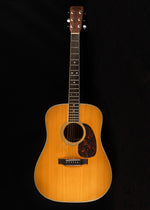
1968 Martin D-35, SN: 231302
The Martin D-35 is the first new dreadnought sized guitar to enter the Martin lineup since the introduction of the D-18, D-21 and the D-28 in the 1930’s. The increasing scarcity of large Brazilian rosewood sets for “D” size instruments spurred the introduction of the new model. Martin did have a healthy supply of this rare tonewood, but mostly in smaller sizes for smaller guitars, so the decision was made to utilize these materials for the manufacture of “D” size guitars with three piece backs.
The design team didn’t stop there. They didn’t want to simply offer a D-28 with a three piece back. At the time, customers expressed interest in new guitars made with pre-war and wartime Martin style smaller, scalloped bracing. D-35 prototypes were built with a mix of standard D, 000 and 00 size bracing to reflect this demand. The resulting production model has lighter 00 bracing for the top and 000 for the back. The overall pattern of the bracing is still the standard “D” size, but the braces themselves are slimmed down in a manner similar to those of the smaller guitars.
There are cosmetic changes as well. The fingerboard is bound ebony with pearl dot markers at the fifth, seventh, ninth, twelfth, fifteenth and seventeenth frets. The headstock is largely unchanged, with a Brazilian rosewood headplate, unbound and with the C.F Martin & Co. decal above six original patent pending Grover Rotomatic tuners in chrome. Unlike the D-28, there is no volute joining the neck to the headstock. The nut width is 1 11/16” and there are 20 medium size frets. The bridge is ebony with the then-new drop in saddle. The pickguard was originally another new feature: black celluloid. These have a tendency to curl up over time, so this one has been replaced with a more traditional pepperoni style in a size slightly larger than the original.
The rosette is unchanged from the D-28. The binding, in white celluloid is unchanged as well, though the purfling is now five ply in a white and black pattern for the top, four ply for the sides, both at the top and back edge of the rim and two ply for the back. The D-28’s center strip is replaced here with a pair of offset strips, three ply with ebony bound by boxwood. The heel cap is a five ply laminate reflecting the pattern of the rim purfling.
This example shows signs of careful repair and maintenance over the years. The pickguard, as previously described, is a replacement. The bridge is likely original, but it has been reset and a crack through the pins has been reglued. The neck has been reset and it is now set for bluegrass play, with action at the 12th fret set at 7/64” for the low E and 5/64” for the high e string. The binding on the neck shows a few shrinkage hairlines in a few places where the binding meets a few of the fret ends. The finish, overall, is a little bit cloudy. This is a common trait of Martins from this era.
There were a number of different versions of the D-35 over the years. This guitar is an example of the first version, with a small maple bridge plate mounted inside under the bridge. Instruments made not long after this one are built with a large rosewood bridgeplate, which changes the tone dramatically. A couple of years later, Brazilian rosewood would change over to Indian rosewood with another resulting change in tone. These first generation D-35’s are scarce and sought after for a uniquely sweet, lighter tone than their D-28 brethren, with plenty of whomp and dynamic range when needed. The tone is unlike any of the previous dreadnought models: the new D-35 design is its own thing.











